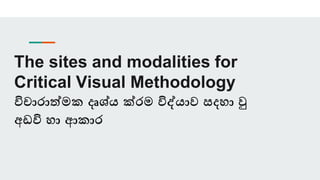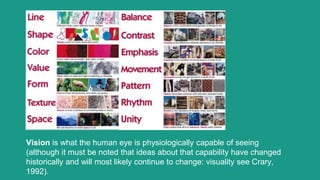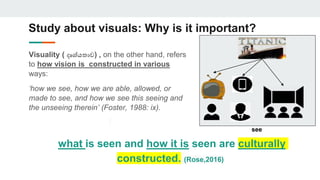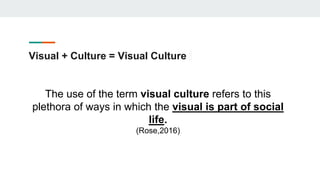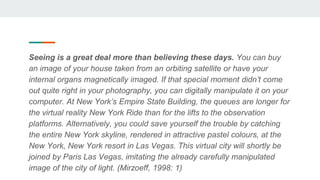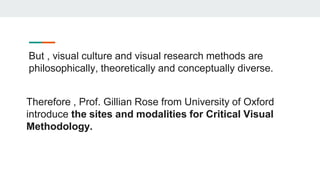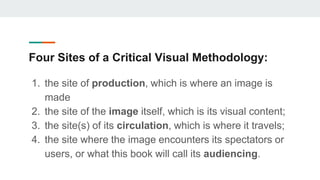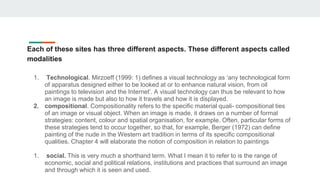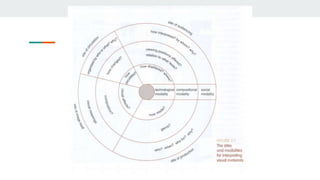The sites and modalities for Critical Visual Methodology
- 1. The sites and modalities for Critical Visual Methodology ÓĘĆÓĘÆÓČĀÓĘÅÓČ╗ÓĘÅÓČŁÓĘŖÓČĖÓČÜ ÓČ»ÓĘśÓĘüÓĘŖÓČ║ ÓČÜÓĘŖÓČ╗ÓČĖ ÓĘĆÓĘÆÓČ»ÓĘŖÓČ║ÓĘÅÓĘĆ ÓĘāÓČ»ÓĘäÓĘÅ ÓĘĆÓĘö ÓČģÓČ®ÓĘĆÓĘÆ ÓĘäÓĘÅ ÓČåÓČÜÓĘÅÓČ╗
- 3. Vision is what the human eye is physiologically capable of seeing (although it must be noted that ideas about that capability have changed historically and will most likely continue to change: visuality see Crary, 1992).
- 4. Visuality ( ÓČ»ÓĘśÓĘüÓĘŖÓČ║ÓČŁÓĘÅÓĘĆ) , on the other hand, refers to how vision is constructed in various ways: ŌĆśhow we see, how we are able, allowed, or made to see, and how we see this seeing and the unseeing thereinŌĆÖ (Foster, 1988: ix). Study about visuals: Why is it important? what is seen and how it is seen are culturally constructed. (Rose,2016) see
- 5. Visual + Culture = Visual Culture The use of the term visual culture refers to this plethora of ways in which the visual is part of social life. (Rose,2016)
- 6. Visuals in Postmodernity (ÓČ┤ÓĘüÓĘŖÓČĀÓĘÅÓČŁÓĘŖ ÓČ▒ÓĘ¢ÓČŁÓČ▒ÓČŁÓĘŖÓĘĆÓČ║) More Complex
- 7. ŌĆ£ in postmodernity it is no longer possible to make a distinction between the real and the unreal; images have become detached from any certain relation to a real world with the result that we now live in a scopic regime dominated by simulations, or simulacra.ŌĆØ Jean Baudrillard (1988)
- 8. Seeing is a great deal more than believing these days. You can buy an image of your house taken from an orbiting satellite or have your internal organs magnetically imaged. If that special moment didnŌĆÖt come out quite right in your photography, you can digitally manipulate it on your computer. At New YorkŌĆÖs Empire State Building, the queues are longer for the virtual reality New York Ride than for the lifts to the observation platforms. Alternatively, you could save yourself the trouble by catching the entire New York skyline, rendered in attractive pastel colours, at the New York, New York resort in Las Vegas. This virtual city will shortly be joined by Paris Las Vegas, imitating the already carefully manipulated image of the city of light. (Mirzoeff, 1998: 1)
- 10. Analog to Digital Many commentators argue that the emergence of a wide range of digital production, storage and communication devices over the past twenty years has significantly changed visual culture. They argue not only that these inventions account in large part for the pervasiveness of visual images in Western societies now - because they make images so easy to make and share - but also that the nature of digital images is changing contemporary visualities. This claim is built on the difference between analogue images and digital images ( Gillian Rose,2016)
- 11. Images made with digital cameras should not be called photographs. The chemical process that creates analogue photographs gives them a unique quality which digital images do not and cannot have, such that ŌĆśone feels or intuits in digital images that the qualitative expression of duration found in photography and film is missing or sharply reduced. (David Rodowick ,2007: 118).
- 12. This is why we need critical approach to understand visual Visual imagery is never innocent; it is always constructed through various practices, technologies and knowledges. A critical approach to visual images is therefore needed: one that thinks about the agency of the image, considers the social practices and effects of its circulation and viewing, and reflects on the specificity of that viewing by various audiences, including the academic critic. ( Gillian Rose,2016)
- 13. But , visual culture and visual research methods are philosophically, theoretically and conceptually diverse. Therefore , Prof. Gillian Rose from University of Oxford introduce the sites and modalities for Critical Visual Methodology.
- 14. Four Sites of a Critical Visual Methodology: 1. the site of production, which is where an image is made 2. the site of the image itself, which is its visual content; 3. the site(s) of its circulation, which is where it travels; 4. the site where the image encounters its spectators or users, or what this book will call its audiencing.
- 15. Each of these sites has three different aspects. These different aspects called modalities 1. Technological. Mirzoeff (1999: 1) defines a visual technology as ŌĆśany technological form of apparatus designed either to be looked at or to enhance natural vision, from oil paintings to television and the InternetŌĆÖ. A visual technology can thus be relevant to how an image is made but also to how it travels and how it is displayed. 2. compositional. Compositionality refers to the specific material quali- compositional ties of an image or visual object. When an image is made, it draws on a number of formal strategies: content, colour and spatial organisation, for example. Often, particular forms of these strategies tend to occur together, so that, for example, Berger (1972) can define painting of the nude in the Western art tradition in terms of its specific compositional qualities. Chapter 4 will elaborate the notion of composition in relation to paintings 1. social. This is very much a shorthand term. What I mean it to refer to is the range of economic, social and political relations, institutions and practices that surround an image and through which it is seen and used.
- 17. The sites and modalities for Critical Visual Methodology ÓĘĆÓĘÆÓČĀÓĘÅÓČ╗ÓĘÅÓČŁÓĘŖÓČĖÓČÜ ÓČ»ÓĘśÓĘüÓĘŖÓČ║ ÓČÜÓĘŖÓČ╗ÓČĖ ÓĘĆÓĘÆÓČ»ÓĘŖÓČ║ÓĘÅÓĘĆ ÓĘāÓČ»ÓĘäÓĘÅ ÓĘĆÓĘö ÓČģÓČ®ÓĘĆÓĘÆ ÓĘäÓĘÅ ÓČåÓČÜÓĘÅÓČ╗

